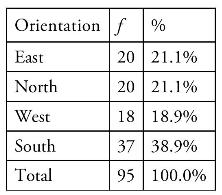An important principle in Sthapatya Veda, a holistic science of architecture, is that buildings should be designed
Question:
An important principle in Sthapatya Veda, a holistic science of architecture, is that buildings should be designed in alignment with the earth's magnetic field and the movement of the sun. Consequently, "a southern orientation of the entrance or sleeping with the head to the north is held to create negative influences" (Travis et al., 2005, p. 555). These researchers "tested the prediction that homes with south entrances would have higher incidents of burglaries" (p. 555) by recording the addresses of 95 burglaries in the crime section of a local newspaper. Next, they went to each address and recorded whether the main entrance of the house was oriented to the east, north, west, or south. The number \((f)\) and percentage of homes in each of the four orientations are provided below:

Conduct the chi-square goodness-of-fit test for these data (assume an equal proportion of burglaries for the four orientations):
a. State the null and alternative hypotheses \(\left(\mathrm{H}_{0}\right.\) and \(\left.\mathrm{H}_{1}\right)\).
b. Make a decision about the null hypothesis.
1, Calculate the degrees of freedom \((d f)\).
2, Set alpha (a), identify the critical value, and state a decision rule.
3, Calculate a statistic: chi-square \(\left(X^{2}\right)\).
4, Make a decision whether to reject the null hypothesis.
5, Determine the level of significance.
6, Calculate a measure of effect size (Cramér's \(\varphi\) ).
c. Draw a conclusion from the analysis.
d. Relate the result of the analysis to the research hypothesis.
Step by Step Answer:

Fundamental Statistics For The Social And Behavioral Sciences
ISBN: 9781483318790
1st Edition
Authors: Howard T. Tokunaga




